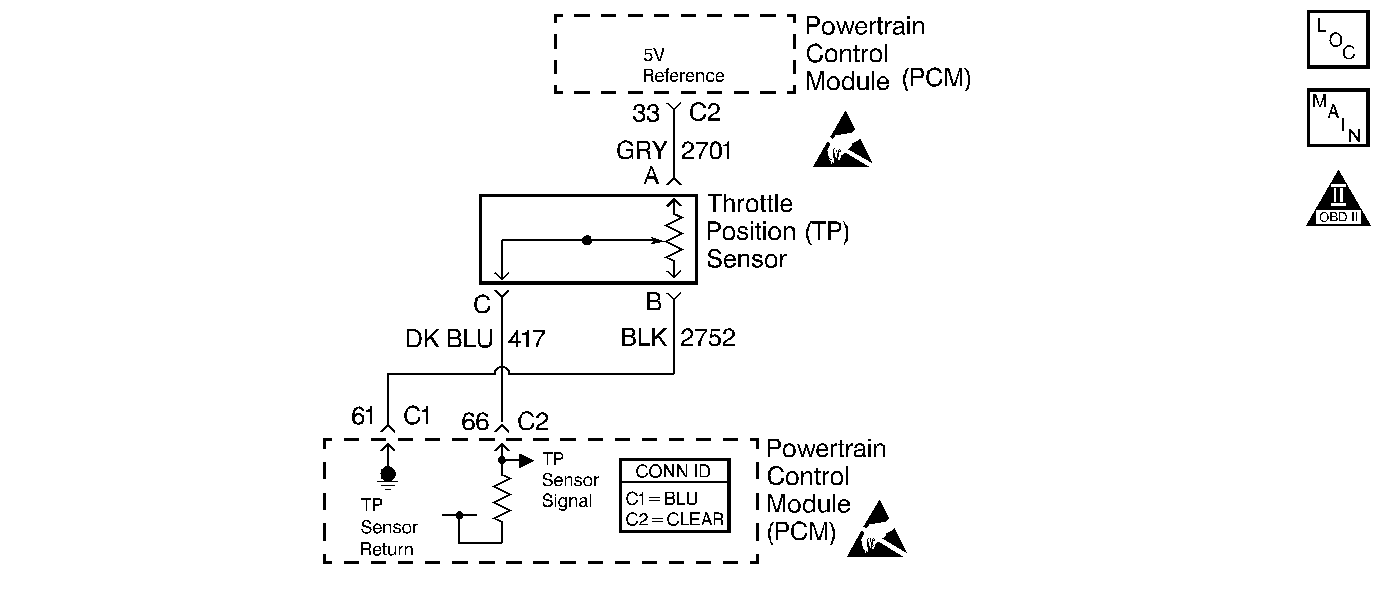
Circuit Description
The Throttle Position (TP) sensor circuit provides a voltage signal that changes relative to throttle blade angle. The signal voltage will vary from below 1.0 volt at closed throttle to above 4.0 volts at Wide Open Throttle (WOT).
When the MAP reading is below 50 kPa the diagnostic checks for a skewed high TP Sensor. When the MAP reading is above 70 kPa the diagnostic checks for a skewed low TP Sensor. If the PCM detects an out of range condition, DTC P0121 will be set. The diagnostic will not run between 50 kPa and 70 kPa.
Conditions for Running the DTC
| • | No active TP, MAP sensor DTC. |
| • | The engine is running. |
| • | The ECT Sensor temperature above 70°C (158° F). |
| • | The MAP reading is below 50 kPa. |
| • | The MAP reading is above 70 kPa. |
| • | The MAP steady for 5 seconds or more. |
Conditions for Setting the DTC
| • | The TP Sensor reading is above the predicted value when the MAP is below 50 kPa. |
| • | The TP Sensor reading is below the predicted value when the MAP is above 70 kPa. |
| • | Above conditions are present for 10 seconds. |
Action Taken When the DTC Sets
| • | The PCM illuminates the malfunction indicator lamp (MIL) on the second consecutive ignition cycle that the diagnostic runs and fails. |
| • | The PCM records the operating conditions at the time the diagnostic fails. The first time the diagnostic fails, the PCM stores this information in the Failure Records. If the diagnostic reports a failure on the second consecutive ignition cycle, the PCM records the operating conditions at the time of the failure. |
| • | The PCM writes the conditions to the Freeze Frame and updates the Failure Records. |
Conditions for Clearing the MIL/DTC
| • | The PCM will turn OFF the malfunction indicator lamp (MIL) during the third consecutive trip in which the diagnostic has run and passed. |
| • | The history DTC will clear after 40 consecutive warm-up cycles have occurred without a malfunction. |
| • | The DTC can be cleared by using a scan tool. |
Diagnostic Aids
Check for the following conditions:
Skewed MAP signal or faulty MAP sensor. A skewed MAP signal may cause the PCM to incorrectly determine the TP Sensor is out of range. Check for an unusually low or high MAP reading. This condition can cause DTC P0121 to be set. Refer to Manifold Absolute Pressure Sensor Circuit Diagnosis
Important: : Remove any debris from the connector surfaces before servicing a component. Inspect the connector gaskets when diagnosing or replacing a component. Ensure that the gaskets are installed correctly. The gaskets prevent contaminate intrusion.
| • | Poor terminal connection. |
| Inspect the harness connectors for backed out terminals, improper mating, broken locks, improperly formed or damaged terminals, and faulty terminal to wire connection. Use a corresponding mating terminal to test for proper tension. Refer to Intermittents and Poor Connections Diagnosis , and Connector Repairs Wiring Systems. |
| • | Damaged harness. |
| Inspect the wiring harness for damage. If the harness appears to be OK, observe the sensor display on the scan tool while moving connectors and wiring harnesses related to the sensor. A change in the sensor display may indicate the location of the fault. Refer to Wiring Repairs in Wiring Systems. |
| • | Inspect the PCM and the engine grounds for clean and secure connections. |
If the DTC is determined to be intermittent, reviewing the Fail Records can be useful in determining when the DTC was last set.
Test Description
The numbers below refer to the step numbers on the Diagnostic Table.
-
An incorrect MAP signal may cause the PCM to incorrectly calculate the predicted TP sensor value during high engine load situations. Check for an unusually low MAP reading. This condition can cause DTC P0121 to be set.
-
This vehicle is equipped with a PCM which utilizes an Electrically Erasable Programmable Read Only Memory (EEPROM). When the PCM is being replaced, the new PCM must be programmed. Refer to Powertrain Control Module Replacement/Programming .
Step | Action | Value(s) | Yes | No | ||||||
|---|---|---|---|---|---|---|---|---|---|---|
1 | Was the Powertrain on Board Diagnostic System Check performed? | -- | ||||||||
Is MAP reading less than the specified value? | 55 kPa | |||||||||
3 |
Is MAP reading less than the specified value? | 95 kPa | ||||||||
4 |
Was the MAP signal circuit open or shorted? | -- | ||||||||
5 | Replace the MAP sensor. Refer to Manifold Absolute Pressure Sensor Replacement . Is the action complete? | -- | -- | |||||||
6 | Observe the TP Angle reading on the scan tool while slowly opening the throttle. Does TP Angle increase steadily and evenly from the closed throttle value to the wide open throttle value?
| 0% 100% | Go to Diagnostic Aids | |||||||
7 |
Is the TP sensor reading near the specified value? | 0.0V | ||||||||
8 |
Is the TP sensor reading at the specified value? | 5.0V | ||||||||
9 |
Was a problem found? | -- | ||||||||
10 | Check the following items:
Was a problem found? | -- | ||||||||
11 | Replace the TP sensor. Refer to Throttle Position Sensor Replacement . Is the action complete? | -- | -- | |||||||
|
Important: : Replacement PCM must be programmed. Refer to Powertrain Control Module Replacement/Programming . Replace the PCM. Is the action complete? | -- | -- | ||||||||
13 |
Does scan tool indicate DTC P0121 failed this ignition? | -- | System OK |
